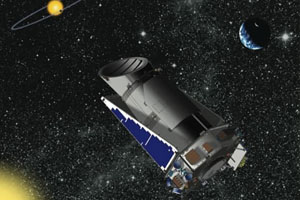 NASA’s deep-space Kepler probe has found hundreds of new planets — many similar to earth — sparking new hope of life outside our solar system.
NASA’s deep-space Kepler probe has found hundreds of new planets — many similar to earth — sparking new hope of life outside our solar system.
The National Aeronautics and Space Administration confirmed Sunday that in six weeks of operation, the spacecraft has found five new solar systems in the Milky Way and identified more than 700 bodies that could be new planets.
NASA has so far formally announced only five new exoplanets — planets outside our solar system — but early data analysis indicates up to 140 of the 700 identified bodies are earth-like. That is, they are solid masses containing both land and water which could allow simple lifeforms to develop.
“The figures suggest our galaxy, the Milky Way [which has more than 100 billion stars] will contain 100 million habitable planets, and soon we will be identifying the first of them,†Dimitar Sasselov, professor of astronomy at Harvard University and a scientist on the Kepler Mission, told Fox News Sunday.
“There is a lot more work we need to do with this, but the statistical result is loud and clear, and it is that planets like our own Earth are out there.”
The Kepler probe was launched more than a year ago but has only been in position to monitor space outside our solar system since mid-June. The probe examines distant stars by evaluating the light they give off.
The probe is constantly monitoring the brightness of more than 100,000 stars in three constellations in the Milky Way — Cygnus, Lyra and Draco. Using a massive telescope equipped with a 95-megapixel camera, the space platform is able to detect, record and analyze the passage of planets around those stars by measuring the changes in light emission.
This is how NASA describes the process on its Kepler Mission website:
“Once detected, the planet’s orbital size can be calculated from the period (how long it takes the planet to orbit once around the star) and the mass of the star using Kepler’s Third Law of planetary motion.
“The size of the planet is found from the depth of the transit (how much the brightness of the star drops) and the size of the star.
“From the orbital size and the temperature of the star, the planet’s characteristic temperature can be calculated. From this the question of whether or not the planet is habitable (not necessarily inhabited) can be answered.”
To qualify as a “candidate planet” the telescope must record light being distorted three times to ensure the results are not just an anomaly.
Planets found so far include CoRoT – 7b, a rocky orb almost five times the size of Earth but with a molten side because it orbits its star extremely closely, Britain’s Daily Mail newspaper said Sunday.
The largest is Wasp-17b, which has a radius of about 100,000 km compared to Earth’s 6,000 km.
The Kepler mission is expected to last four years.
Source : http://www.torontosun.com/news/world/2010/07/25/14822461.html